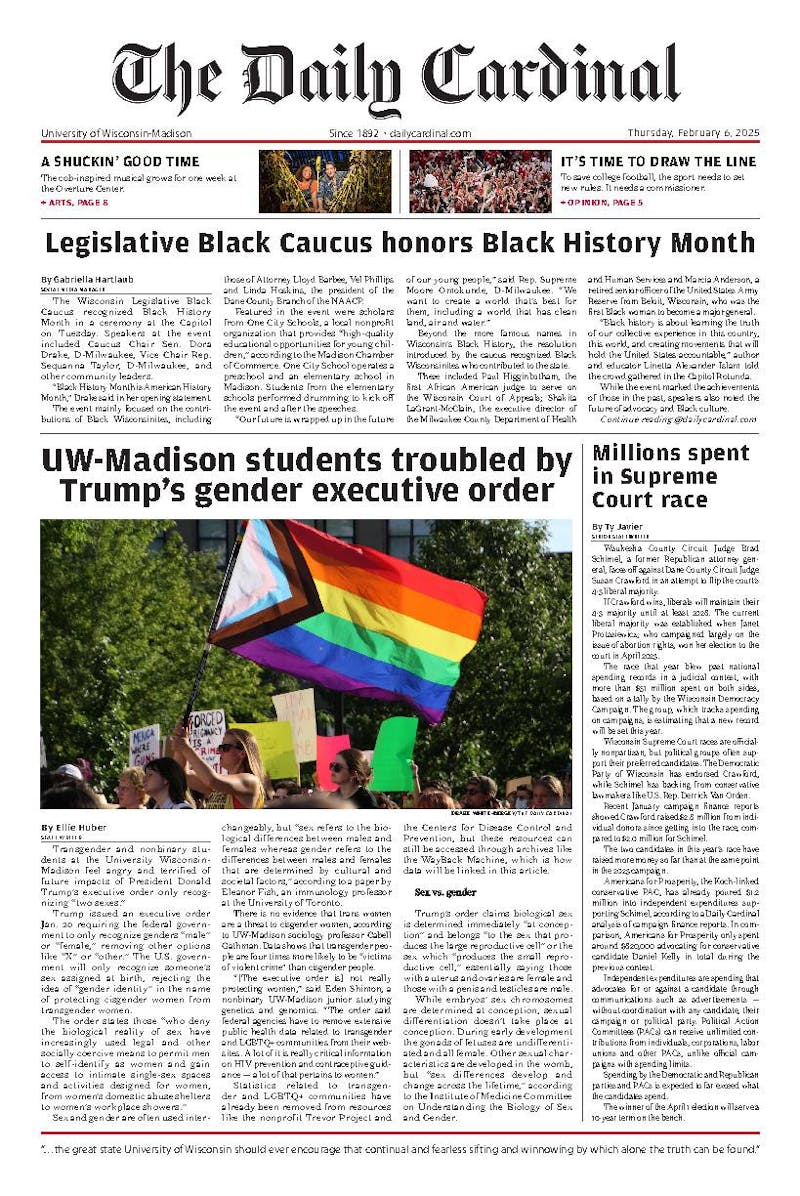I'm sure you remember ""I'll huff, and I'll puff, and I'll blow your house down!"" Since we were little kids, we have learned to fear the wolf, the ""savage"" killer. Their eerie howl causes chills to run down the spine of anyone in earshot. In reality, the wolf is a vital predator, essential to the ecosystems it inhabits. In recent years, Wisconsin has been blessed with the reintroduction of wolves following migration from upper Minnesota. Lately, however, this blessing has become too much of a good thing.
Wolf populations have grown beyond their carrying capacity, endangering their habitat. For this reason, the grey wolf of the Western Great Lakes Distinct Population Segment (consisting mostly of Minnesota, Wisconsin, and Michigan) was removed from the Endangered Species List in 2009, according to the U.S. Fish and Wildlife Service.
Unfortunately, lawsuits from the Humane Society of the United States and other groups have successfully put the grey wolf back on the list. This denies the Wisconsin Department of Natural Resources the hunting power they need. It's simple: since there are too many wolves, we need to remove them from the endangered species list so the DNR can carry out a controlled harvest.
In 1999, the Wisconsin DNR formed a management plan, setting a goal for wolf recovery at 350 animals in the state. They estimated the state carrying capacity at around 500, but at the time these guidelines were set, the wolf population was estimated at about 205. Just 11 years later, the wolf population is estimated to be 690. In that short time span, the population almost tripled, almost doubling the DNR goal. This year, wolf numbers are 190 above the estimated carrying capacity.
Without human intervention, wolf numbers are controlled through starvation. When wolf numbers grow too high, they kill too many animals of prey, in turn leading many predators to starve. This allows prey numbers to grow once again. Human intervention would prevent the growth of prey species to recover from heavy predation, in the form of both hunting and habitat destruction.
High wolf numbers could have potentially devastating consequences on the wildlife of northern Wisconsin, especially on the whitetail deer, the number one food source for Mid-western wolves. According to the International Wolf Foundation, a single wolf on average kills 15 to 19 deer per year. With the current population of wolves, around 12,000 deer are killed each year. This is especially devastating in northern Wisconsin, where deer populations are sparse—in some areas as low as five deer per square-mile. This not only has terrible consequences for northern Wisconsin's ecosystem, but it harms the economy as well.
Deer hunting in Wisconsin is a multi-million dollar industry. Tourism money brought in by hunters is essential to for government services. In order to keep the deer population healthy, the wolf population must be kept under control.
The recent growth of the wolf population facilitates an alarming increase in human interaction with wolves. Wisconsin Outdoor News states that in 2007 wolves killed 30 cattle, six sheep, a horse and caused a number of livestock injuries in the state.
An overabundance of wolves equals a headache for farmers. In addition to livestock and monetary losses, wolves can cause major stress to a farmer's herd. Yet wolf control techniques can be costly, time-consuming and are not always effective. Wisconsin Outdoor News shows the DNR's cost of livestock reimbursement charges for 2006 were as high as $118,000. This is money that could be spent towards numerous constructive applications, such as research, game-law enforcement and preservation of wild habitat.
For the good of wolves in Wisconsin, numbers must be culled before negative interaction with humans becomes a serious threat and public opinion turns against their presence altogether.
A controlled harvest would be good for humans and wolves. Hunting or trapping season on wolves would not only improve the balance and health of the ecosystems they inhabit, but it could provide a large source of money for the DNR.
The Big Bad Wolf that haunted Little Red Riding Hood is far from reality. The wolf is an apex predator, fitting into its ecosystems just as any other animal does. Thus, it should be treated and managed as any other game animal. Controlled harvest is a vital conservation tool in the management of wildlife. A hunting season on wolves would not destroy their population, it would balance it.
These benefits include healthier wildlife populations, enhanced deer hunting, an improved economy, reduced conflicts with humans and their domestic animals and, perhaps most important, positive public opinion. For the benefit of wolves in Wisconsin, they must be removed from the endangered species list and there must be a controlled harvest. A hunting season on wolves will help ensure that their deep, majestic howl can be heard in the Badger state for many generations to come.
Donnie Radcliffe is a freshman majoring in biomedical systems engineering. Please send all feedback to opinion@dailycardinal.com.






